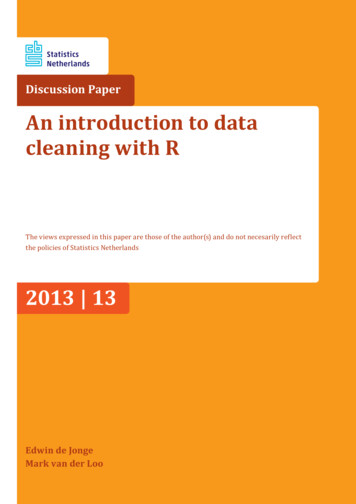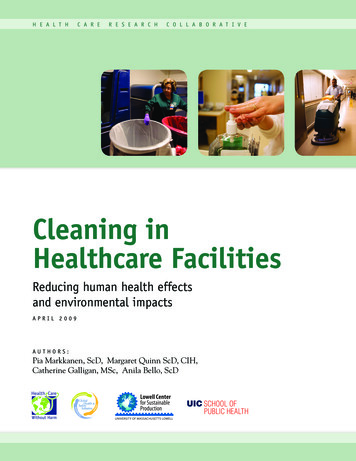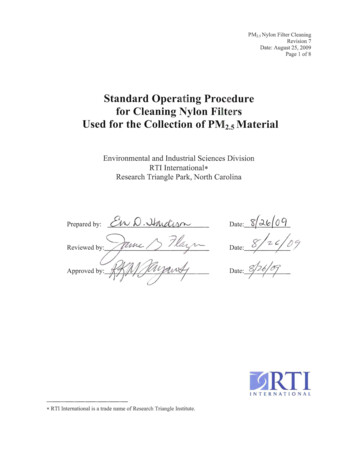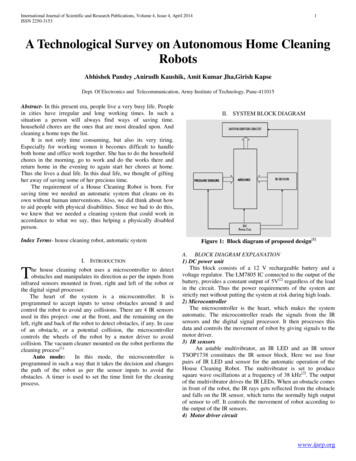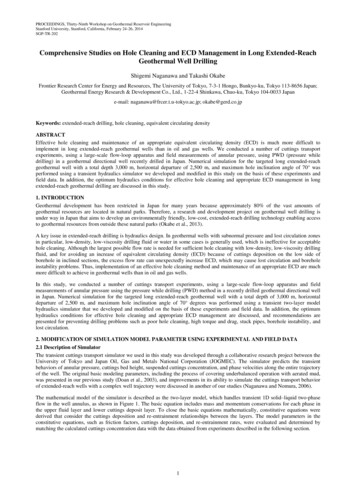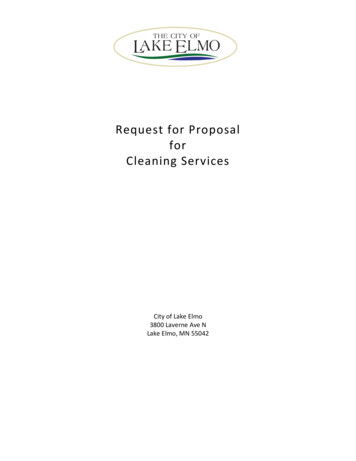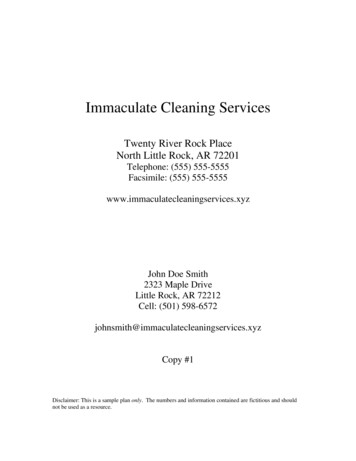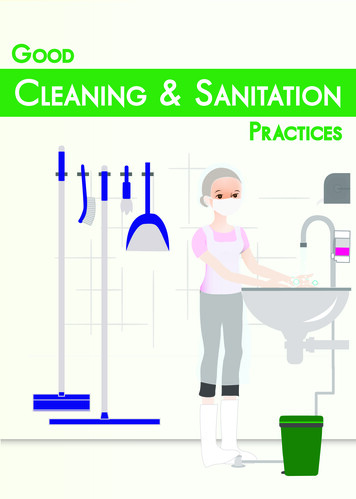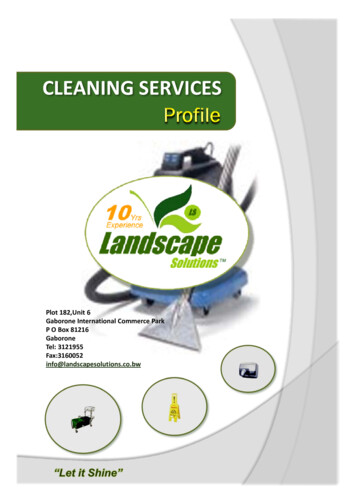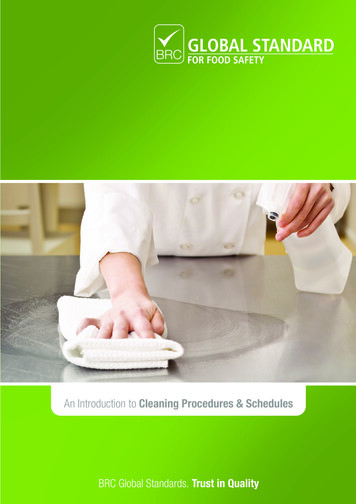
Transcription
An Introduction to Cleaning Procedures & SchedulesBRC Global Standards. Trust in Quality
Cleaning Procedures and SchedulesCleaning Procedures and SchedulesAs a food manufacturer it’s important you maintain a suitable level of cleanliness throughout your site.The easiest way to achieve this is with a detailed cleaning schedule alongside procedures that establish how the cleaning will be carriedout. While documentation systems on their own do not give a clean production facility, documented cleaning procedures which areefficiently implemented will ensure the cleaning is completed in a consistent and effective manner, and this is a key tool to maintainproduct integrity and in the production of safe products.1.0 Requirements of the BRC Global Standard for Food SafetyIn the BRC Global Standard for Food Safety, clause 4.11.1 states:Documented cleaning procedures shall be in place and maintained for the building, plant and all equipment.Cleaning procedures shall as a minimum include the: responsibility for cleaning item/area to be cleaned frequency of cleaning method of cleaning, including dismantling equipment forcleaning purposes where required cleaning chemicals and concentrations cleaning materials to be used cleaning records and responsibility for verificationThe frequency and methods of cleaning shall be based on risk.The procedures shall be implemented to ensure appropriate standards of cleaning are achieved.2.0 How this short guide can helpThis short guide will help you put procedures in place to ensure your cleaning activities are carried out consistently and thoroughly.This will prevent potential risks including microbiological, allergen or chemical contamination, which you may otherwise get from dirtyequipment or an unclean manufacturing environment.You’ll need to document all the cleaning carried out, as this will help you to: ensure all relevant areas and equipment are included within the schedule make sure the required standard of cleaning is clearly defined so you have consistent completion of cleaning activities ensure there is continuous compliance with relevant hygiene legislation train staff effectivelyIt’s important to note that your cleaning schedule is not a standalone document: it must be used in conjunction with food hygienelegislation, risk assessment and other records, for example, chemical use information, verification activity and cleaning records.F057 Issue 128/8/2013Introduction to Cleaning Procedures and SchedulesPage 1 of 7
Cleaning Procedures and Schedules3.0 Developing an effective cleaning procedureIn order for your cleaning to be effective it’s important that the procedures are designed for the specific item, area or site. A generic,off-the-shelf procedure probably wouldn’t guarantee a sufficient standard of cleaning. For example, an identical work surface in an areahandling bakery products may need to be treated differently to one in a meat handling area. This would need to be assessed during thedevelopment and risk assessment stage.In addition, you need to think about the complexity of the process/equipment, types of products manufactured, and how easy it is toremove debris, and the need to manage specific hazards e.g. specific micro-organisms or allergens.Developing your cleaning procedure can be done in a few simple steps:Step 1: Set the required standard of cleaning (Clause 4.11.2)Consider legislation, customer requirements, industry or category best practice, etc. Your risk assessment should consider the preventionof contamination from previous products, as well as address potential microbiological, chemical or allergen concerns.Step 2: Develop the draft procedures. Ensure all items/areas/equipment are defined and included within the procedures. Think about theorder of cleaning too so that cleaned equipment isn’t re-contaminated by subsequent cleaning activity.Step 3: Validate the draft procedures (Clause 4.11.2).Validation is used to confirm that the required level of cleaning (Step 1) is met.Step 4: Finalise procedures and associated documentation (e.g. cleaning records and sign off)Step 5: Train relevant staffStep 6: Complete ongoing monitoring and verification (Clauses 4.11.1 and 4.11.4)4.0 What’s included in a cleaning procedure? The equipment, plant or building that needs cleaning, how often and using which methods. Particular attention is needed where thereare identical or similar items to ensure they’re all cleaned to the correct schedule. Clear instructions outlining the step-by-step process which staff responsible for cleaning need to follow. Instructions on the correct/safe dismantling of equipment or other pre-cleaning activity (e.g. disconnecting the electric supply) wherethis is required. The frequency of cleaning e.g. daily, weekly, monthly or annually. Think also about when the activity should be completed, for example adaily clean might be overnight, at the end of a shift or between products. Where equipment requires different levels of cleaning e.g. a clean between products, a routine daily clean and a weekly deep clean. Eachset of requirements should be detailed separately. The chemicals used for cleaning should be fully detailed and should include any relevant handling instructions or dilutions. The equipment or utensils used during the activity e.g. mops, brushes or cloths. The staff responsible for completing the cleaning, supervision (sign off) and verification activity.F057 Issue 128/8/2013Introduction to Cleaning Procedures and SchedulesPage 2 of 7
Cleaning Procedures and Schedules5.0 Additional items for your cleaning procedureIn addition, a good cleaning instruction may include: A unique method reference that can be quoted on paperwork e.g. cleaning records. Photographs of equipment, which is useful for identifying equipment and for highlighting areas that are difficult to clean orkey check/verification points. The appropriate protective clothing/equipment that should be worn when cleaning or handling cleaning chemicals. An example of a good cleaning procedure is shown in Appendix 1.6.0 Keeping recordsYou’ll need to keep records that show what type of cleaning was completed, when it was completed, who did the cleaning and whochecked and signed off the cleaning as acceptable (a requirement of clause 4.11.4).An example of a cleaning record is shown in Appendix 2.7.0 Ongoing checksVerification is the application of checks or tests, at regular intervals, to ensure the cleaning procedure is still working and continues todeliver the required level of cleaning. Verification of cleaning may include internal audits, record reviews, swabs or tests of the cleanedequipment and the assessment of staff to ensure they have a clear understanding of the cleaning procedure.Cleaning procedures should be reviewed whenever there are changes to the area, equipment or processes including the introduction ofnew products or the use of new ingredients.Quick Tips Ensure all equipment and areas are included Discuss cleaning needs with equipment and chemical suppliers Remember that validation and verification is needed for cleaning activitiesThese short guides are designed for companies involved in the enrolment program and aim to help you interpret the Standard and designrobust systems and procedures that meet the requirements. Examples are given to explain the types of documents and procedures andthe level of detail typically required. However, you’ll need to consider the context relevant to your business. The implementation of theStandard, and whether a resulting system is considered to be conforming or non-conforming by an auditor, is an objective judgementwhich can only be based on the evidence collected and observations made during the audit.Further details regarding the BRC Global Standard for Food Safety can be obtained from enquiries@brcglobalstandards.comF057 Issue 128/8/2013Introduction to Cleaning Procedures and SchedulesPage 3 of 7
Cleaning Procedures and SchedulesABCDEFGHIAUnique method referenceBClear identification of area or equipmentCResponsibility for cleaning & sign offDCleaning utensils/tools to be usedECleaning chemicals with appropriate concentrations and instructionsFAppropriate protective clothingGInstructions for dismantling & other precautionsHCleaning frequency (this may contain more than one section if the equipment has routine and periodic deep cleaning)IStepwise cleaning instructionsF057 Issue 128/8/2013Introduction to Cleaning Procedures and SchedulesPage 4 of 7
Cleaning Procedures and SchedulesKey focus points formonitoring/verificationactivitiesPhotographs to aidcleaning of all relevantareas(Example of a cleaning procedure provided courtesy of Holchem Laboratories Ltd)F057 Issue 128/8/2013Introduction to Cleaning Procedures and SchedulesPage 5 of 7
F057 Issue 128/8/2013DailyDailyDailyA2 Bowl Mixer 1A2 Bowl Mixer 2A3 Spiral ChillerA1A1A1Document ignWedCleanSignCheckSignThuIssue Date/Version NumberCleanSignTueWeek Comencing:Frequency CleanSignConveyor 1Equipment/AreaA1MethodSite Area: nSatCheckSignSunCleanSignIssued/Authorised ByCheckSignFriCleaning Procedures and SchedulesAppendix 2 – Example of a Cleaning RecordIntroduction to Cleaning Procedures and SchedulesPage 6 of 7
BRC Trading Limited21 Dartmouth Street, London SW1H 9BPT. 44 (0)20 7854 8900 F. 44 (0)20 7854 8901 E. com
Step 3:Validate the draft procedures (Clause 4.11.2). Validation is used to confirm that the required level of cleaning (Step 1) is met. Step 4:Finalise procedures and associated documentation (e.g. cleaning records and sign off) Step 5:Train relevant staff.
